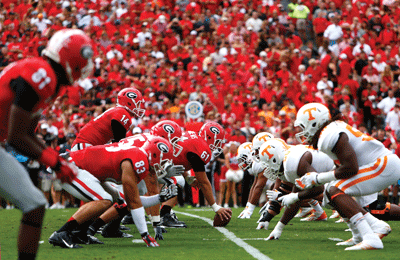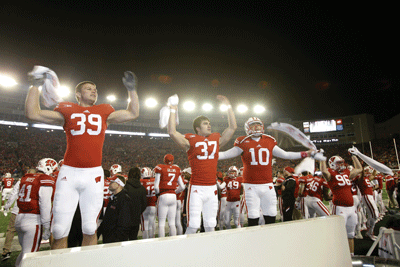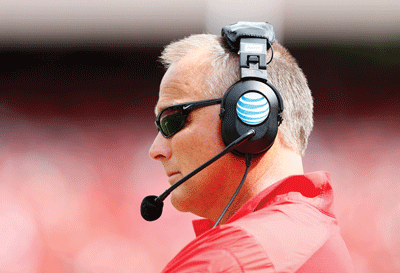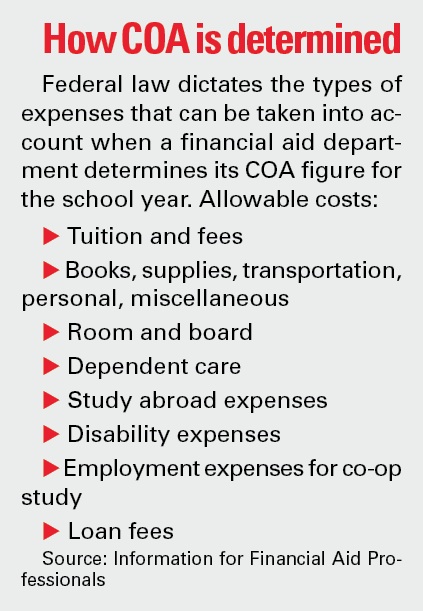The start of a new school year ushers in a new financial reality for college athletic departments and, with it, questions about the hot new statistic in college sports: cost of attendance, or COA.
Schools use cost of attendance to determine a student’s need for financial aid, and federal law dictates the types of expenses that can be taken into account when a financial aid department determines its COA figure for the academic year. Athletic departments have traditionally provided grants-in-aid to cover a majority of COA components — tuition, books, room and board — but NCAA rules have prohibited them from covering travel/transportation and personal and miscellaneous expenses.
 |
SEC programs like Tennessee and Georgia will have to submit methodology for determining cost of miscellaneous expenses in their cost of attendance figures. Comments from Georgia coach Mark Richt (below) have drawn attention to the potential for manipulating the formulas.
Photos by: GETTY IMAGES
|
In January, however, the power five conferences — the ACC, Big 12, Big Ten, Pac-12 and SEC — granted the ability to offer student athletes stipends to cover the full cost of attendance, and the other Division I football conferences followed suit.
And that’s where the questions come in. The methods that financial aid offices use to determine figures for travel and personal expenses differ from school to school. Different methods mean some schools offer larger stipends than others, creating a new point of differentiation in the hypercompetitive world of college athletics recruiting.
The change sparked a debate about whether the system could be manipulated to provide higher COAs, and the accompanying recruiting advantage, for some schools. Once COA figures for the 2015-16 academic year became public, many wondered, for example, how the amount of the stipend covering transportation and personal expenses for the University of Tennessee in Knoxville, which is $5,666, could be so much higher than the $1,580 stipend at the University of Southern California in notoriously expensive Los Angeles.
Federal rules require COA to be calculated and listed every year, but there’s no requirement that adjustments be made in each category. School financial aid departments generally use student surveys, the Consumer Price Index, or a combination of the two to determine the cost of the travel and personal expenses components.
Susan Fischer, director of University of Wisconsin’s Office of Student Financial Services, said her office adjusts UW’s COA figure annually. It uses student surveys to determine things like the average amount a student spends on cellphone bills.
In addition to the surveys, the financial aid office does its own research. For example, it calls local apartment complexes to get the latest rent figures. It also prices out the cost of two trips home a year for students, both in-state and out-of-state, based on gas, bus and airline fares.
“Madison is not cheap to fly in and out of,” Fischer said.
Wisconsin’s travel budget this year is $1,030 for in-state students and $1,630 for out-of-state students.

Clemson University’s senior associate director in its Office of Student Financial Aid, Elizabeth Milam, said her department conducts student surveys every year, rotating the expenses covered each year to keep the surveys short and easy to complete. Her department’s goal is to cover all items within a five-year period.
North Carolina State surveys its students biennially to consider increases to items that fall within the transportation and personal categories. For the years in between, the inflation measures shown in the Consumer Price Index and the Higher Education Price Index are used to make adjustments.
While increases are the norm, Krista Ringler Domnick, director of the Office of Scholarships and Financial Aid at N.C. State, said up isn’t the only direction for COA components to go. One of the biggest adjustments her department has made in recent years outside of tuition was eliminating the cost of health insurance from COA figures, thanks to the Affordable Care Act, which allows children to be covered on their parents’ policies through age 26.
With the lack of standards for creating COA figures from school to school, fans and even head coaches have raised concerns with regard to the potential for computations to be manipulated by athletic departments pressuring financial aid officers. But two factors make that unrealistic.
The first is an A-133 audit, also known as the single audit, a universitywide audit required by the federal government based on a university’s receipt of federal assistance. The audits are performed by independent third parties, typically CPA firms, and are required at least biennially, but are performed annually in most states.
The purpose of the A-133 audit is to ensure that management of federal funds is being handled in accordance with federal guidelines, including the guidelines regarding the computation of COA. An unusual increase in a school’s COA should be identified by the auditor and would have to be explained through supporting materials.
The other safeguard is the interest of universities in keeping their COA figures as low as possible. Prospective students use COAs to compare schools, and a higher COA can mean bigger loans and more debt for those requiring financial assistance.
 |
Wisconsin researches how much students must pay for rent, travel and other costs.
Photo by: GETTY IMAGES
|
At the SEC, additional safeguards have been put in place. Each year, schools will be required to provide the conference office with a report regarding the “other expenses” (such as transportation and certain personal expenses) in its COA figure and the methodology used to determine that value.
The conference also will keep an eye on individual adjustments made for student athletes. Federal regulations allow the COA figure to be adjusted on an individual basis for students with a demonstrated need, commonly called the “personal judgment” rule. For example, a student who must commute an exceptional distance each day to live off-campus with an ailing parent might receive an increase for travel.
The SEC introduced a proposal in January to the other power five conferences that would have required schools to report any adjustments made for student athletes on a case-by-case basis to the NCAA. That proposal was voted down, but the SEC will require its members to report to the conference.
Regardless of the safeguards, is there still cause for concern?
University of Georgia football coach Mark Richt is one of several head coaches to make comments that increase speculation around the potential manipulation of COA computations.
“We’ve been very creative in getting our number to a good spot,” Richt told a crowd at UGA Day in July.
Earlier that month, Richt told the Macon Telegraph that there are “some things that can be done in a creative way that is well within the rules that can get us in pretty good shape” regarding COA.

Inside Higher Ed reported Georgia increased its COA figure in a way that allowed the stipend for student athletes to grow from $1,798 a year to $3,221 for in-state students and $3,743 for out-of-state students. Georgia officials said the increase was a result of the financial aid office taking an “overdue” look at whether their transportation and personal expense numbers were up to date.
Georgia officials, like those at other SEC schools, will be required to provide their methodology to the conference office.
Kristi Dosh contributes to Forbes, Campus Insiders and Outkick the Coverage on FoxSports.com as a sports business reporter and analyst. She is the author of the business of college football book “Saturday Millionaires.”









